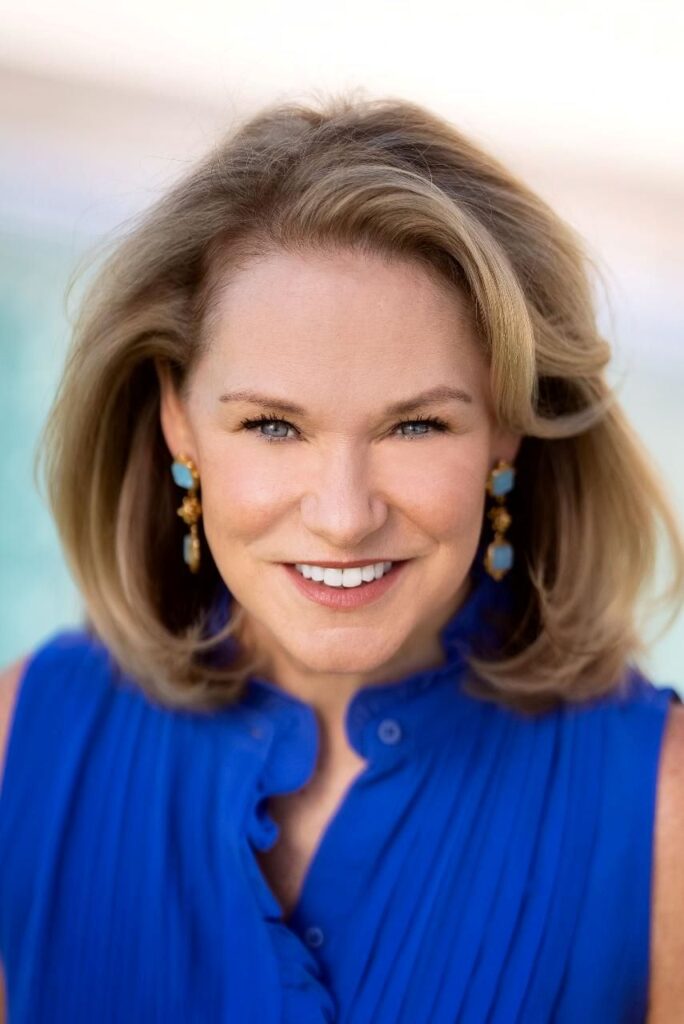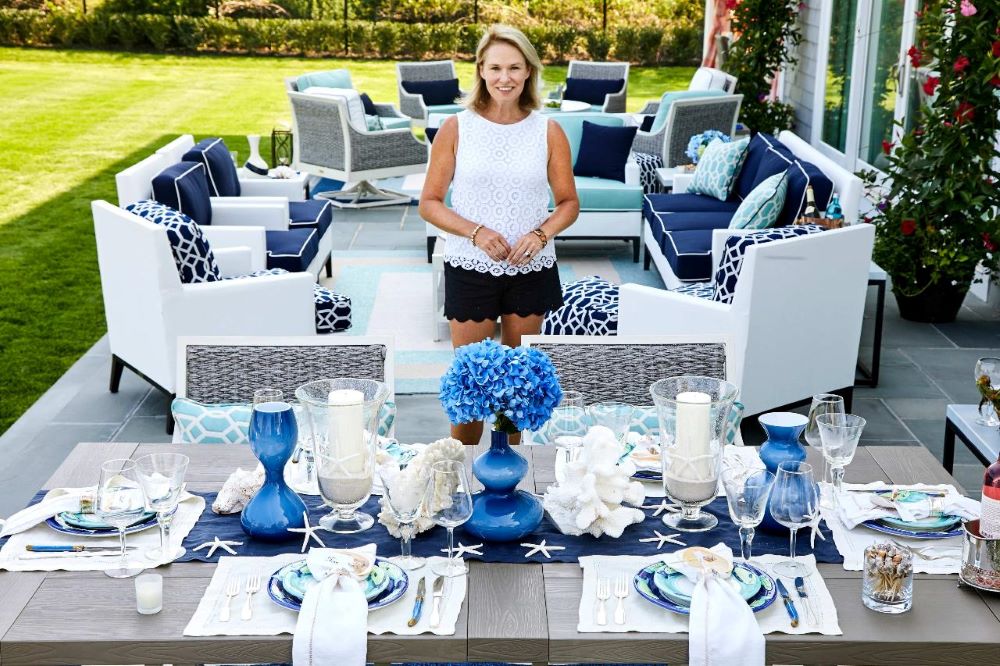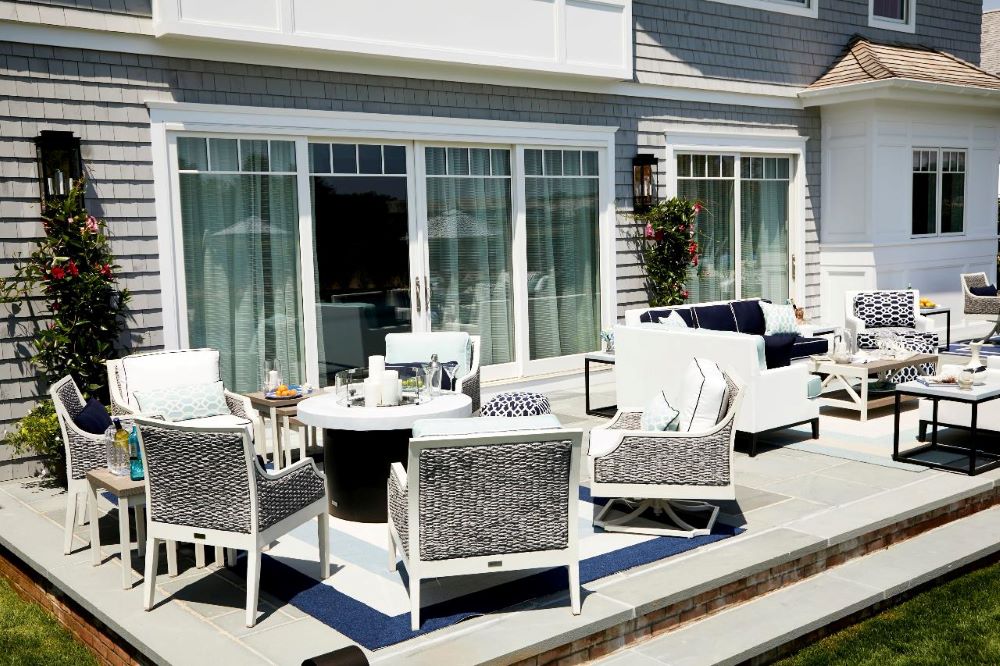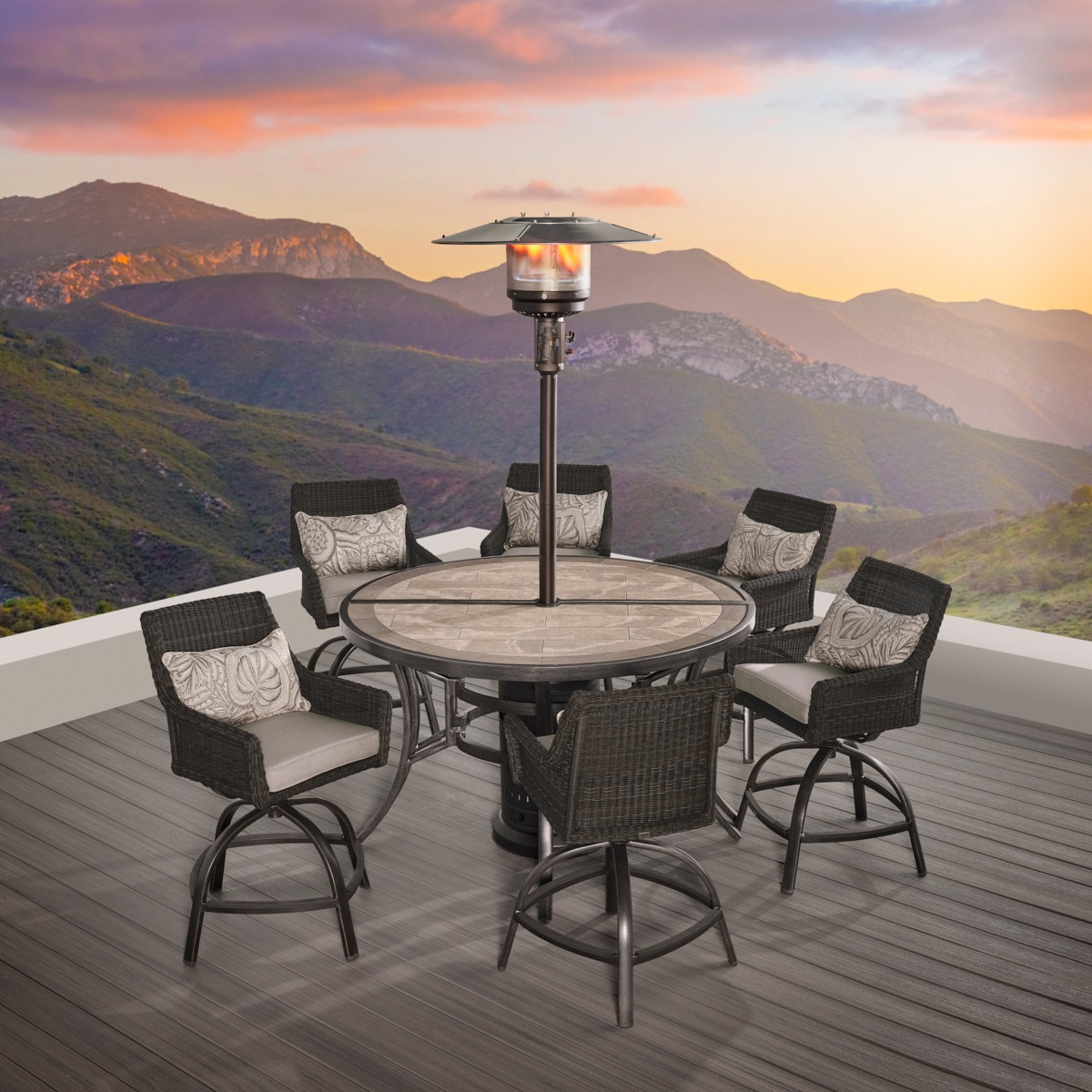Designer Libby Langdon believes in the idea of aligning indoor spaces with outdoor spaces — and she has long taught that both with private clients from coast to coast and with her public followers, notably through her appearances on HGTV’s Small Space, Big Style and Fox TV’s Design Invasion.
“It’s important for people to know how important it is to use their outdoor spaces and think of that square footage as an extension of their interior,” she says. “The same design principles that establish indoor luxury living translate to outdoor luxury living. It’s offering a stylish, comfortable aesthetic that translates to today’s most popular outdoor living products. Combining the finest materials with the latest technology, and livable looks that bring indoor comfort outdoors, it’s creating luxe living regardless of the season or climate.”

Langdon says that using statement pieces like fire tables, outdoor lighting, rugs and accessories evokes a feeling of a complete design similar to a resort, whether seaside or a ski mountaintop.
“Building a luxurious feel comes from creating a sense of a special space and so often that’s inspired by a fabulous vacation or favorite hotel,” she says. “There are so many ways to use that design inspiration and re-create it in a client’s home.
“I also think the more soft goods and rich textures in textiles, throws, pillows and rugs you can incorporate, the more elegant and luxurious an outdoor space feels. I also see when technology like TVs and sound systems are incorporated seamlessly, that gives a sense of living with all the same creature comforts outside, that we live with inside.”

As it turns out, Langdon’s biggest outdoor design challenge is a practical one.
“I think finding outdoor cushions with good drainage is one of my biggest challenges when I’m designing outdoor spaces,” she says. “It’s because people don’t want the hassle of bringing in all their cushions when it rains. Sometimes it forces me to sacrifice product I’d like to use if the cushion construction isn’t practical for the way the client wants their outdoor spaces to function. I want to be able to tell clients that they don’t need to bring them in, they will drain quickly after it rains; that’s a great selling point and it always helps make me seem like a practical design genius!”

From the perspective of design, Langdon says that the lines between indoor and outdoor design have become blurred.
“We use so much outdoor fabric inside because my clients are real people with kids, pets and they love to entertain so performance fabrics are a great option,” she says. “Their home needs to work for their lifestyle rather than their lifestyle to accommodate their home. It’s important to show consumers how to really create an outdoor living room. It’s about taking that valuable square footage and thinking of it as an outdoor addition to your home, not just a deck or a patio.
“It used to be folks would plop down some chairs and a table and call it a day, but it’s a very exciting time now in outdoor décor with all the amazing products that are available. You can be just as creative and dynamic in the design of your outdoor space as you would be in your indoor space. I do think that people are seeing the way they can create a total outdoor living space but often times they have trouble envisioning it and what it will look like completed.”
But once they can, it makes a difference.
“When the consumer can see an outdoor space finished and pulled together with everything from outdoor rugs, lamps, planters and accessories, the same as you’d do in an indoor showroom, they see the potential for their outdoor living space,” says Langdon. “I’ve always seen my clients in warm weather climates see the value in creating an outdoor living room. But I’ve seen a big increase with my colder weather clients realizing that they can use outdoor spaces not just for 12 weeks out of the year but for many, they can use them April through October.”
In a designer-manufacturer relationship, designers say product availability is key, but Langdon will also bypass the process by ordering summer stock in winter to make sure she has what she needs in time. She says that outdoor manufacturers should concentrate on good photography in beautiful, sunny locations to help clients envision themselves living outdoors and loving it.
From a manufacturing perspective, drainage is the No. 1 challenge that Langdon hears from customers.
“We have weatherproof fabrics, rugs and furniture, and if you have weatherproof cushions as a retailer or manufacturer, that’s something that you should really tout. I see the outdoor furniture cover market growing by leaps and bounds, but for me cushions that can be all-weather and also dry out quickly are be a big priority. This is something I really want to be able to offer to my clients!”
Langdon adds that people are also realizing the advantage of mixing and matching various materials in the same outdoor space — an artful mix of wood, rattan, woven wicker, metal, ceramic and glass adds depth and design dimension to a space and gets away from that stale feeling of a matchy-matchy set.
“Sometimes consumers aren’t sure how to achieve the artful mixed look, but that’s where I come in,” she says. “I like to help take the guesswork out of how to mix and match items to make an outdoor space feel more focused and designed and less cookie-cutter.”
Langdon says that the best way designers can learn more about outdoor products is to shop for them.
“We have several wholesale manufacturers that we buy outdoor furniture from,” she says. “I usually go to the showrooms during the High Point Market and ‘kick the tires’ and take some pictures of the pieces in person. Since most of our clients will buy items that we show them in a catalog rather than needing to see it in person, I need to make sure that at least I have had the chance to sit in everything and make sure it’s super comfortable. I like to encourage clients to spend the majority of their outdoor budget on quality furniture pieces with great cushion construction that will be comfortable for many years to come and then save on lower-priced accessories that they can change out each year, like candles, hurricanes, throw pillows and planters.”
She says that she buys accessories not only from wholesalers but also from big-box retailers like Target and HomeGoods and online e-tailers.
“It’s about layering on small, decorative items that add pops of color and the finishing touch to make the exterior living space feel complete,” says Langdon. “I think it’s important to also connect with my clients to see all the different ways they will be using their outdoor spaces.”
She says that those can include such furniture as a comfy chair and table for coffee in the morning; a big table with chairs and an umbrella for long lazy lunches; a cocktail space by the grill where people can gather and chat while cooking; a nighttime dining spot with nice ambient light that’s bright enough but not as glaring as a flood light off the side of the house; or a fire pit surrounded by chairs for late-night chats and cocktails.
“Once I can identify how they will be living in their outdoor spaces, I can then most effectively recommend a layout and furniture combo that will work best for them,” Langdon says. “It’s neat because today these outdoor living needs can be easily addressed with all of the amazing products that are at the ready and standing by for consumers. It’s just up to the outdoor casual living industry and manufacturers as a whole to be clear on their messaging of how people can live in a functional, stylish and beautiful way outdoors and show that by incorporating their products people can fall in love with their outdoor spaces just as much as their indoor spaces!”
Any advice for designers who are only now starting to take on more exterior design?
“Some go-to items I always try to use in outdoor covered porch spaces are outdoor lamps that are weighted and have Sunbrella all-weather lampshades, large area rugs, drapes if they can work with a structure, and great seating areas that can serve more than one purpose,” says Langdon. “I also like adding planters or tall additional potted plants. It helps fill out a space and offers a sense of height and scale and can make spaces feel larger. These days, so many of us can work from our outdoor spaces on a Friday or a Monday (how luxurious is that?) and I make sure there are enough tables that are close to a potential power outlet, or a surge protector under a sofa for charging, small design details like that add functionality but also get folks feeling like their spaces are really working for the needs of their lives!
“I always use throw pillows or small lumbar pillows that allow me to add more fabrics with color pops and patterns. Layering items helps to create a focused, total design. My signature style is ‘Easy, Elegant, Everyday” and it embodies what I feel most of my clients are looking for: approachable and accessible spaces that work for their lifestyles but are also chic and beautiful!
“I find great inspiration in travel magazines, luxury hotel magazines and online outlets like Pinterest and Houzz. Often times when I’m designing a client’s outdoor space, I like to find out what their favorite vacation or getaway place is. I find if I build a space around elements they love when they are away and relaxing the most that they are bound to love an exterior design that echoes that same feeling but now it’s in their backyard! I think it’s important to give someone a sense of place when crafting their design. I like to help the consumer label their look. It helps them to define the look they are going for and it also helps them feel like you are going to give them what they want.
“When I’m setting up my indoor upholstery showroom in High Point in April and October, each vignette has a sense of place. One will be Palm Beach Pretty, one will be Hamptons Cool Coastal, one will be Palm Springs Mod, and this helps me paint the picture because people know what the varying styles are depending on where you are geographically. Labeling a town or state helps me craft the design and make it cohesive and focused. When I paint the picture, it helps the consumer feel like they know what they are about to get and comfortable that it’s going to be what they want. There are big design differences and esthetics between Malibu and Miami. A sense of place allows me to hone in on exactly what my customer wants.”








